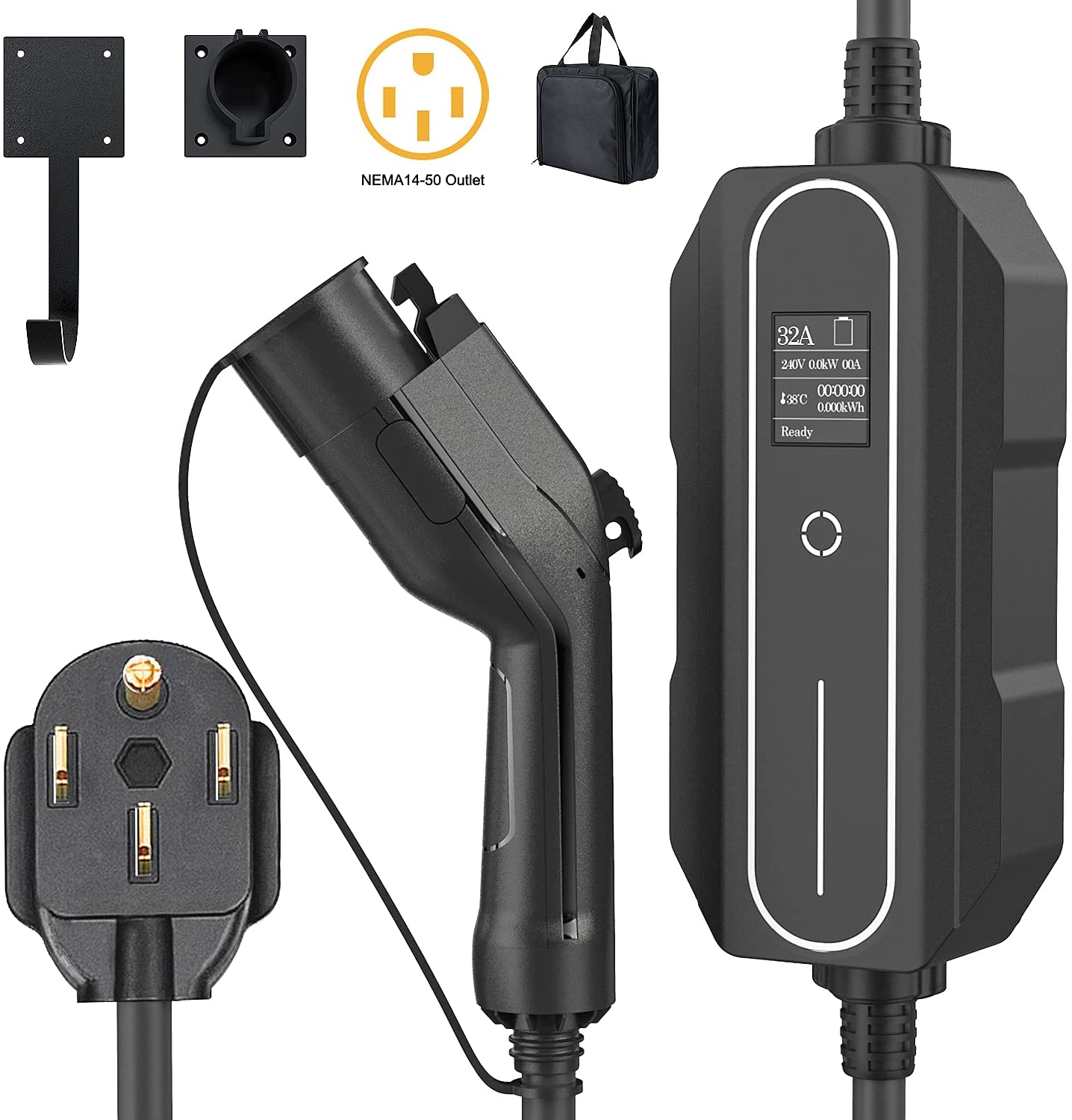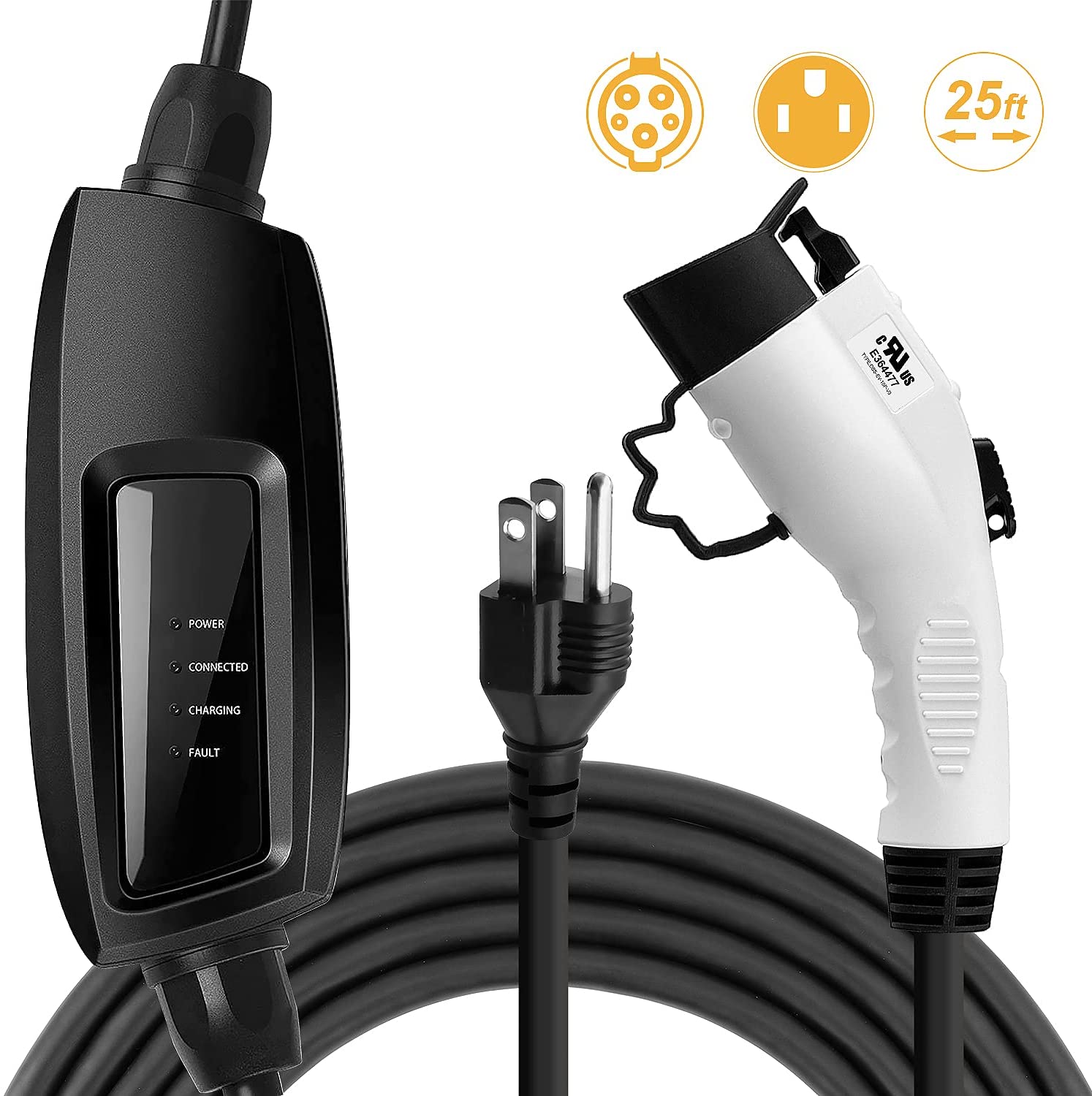PROS: Fast charging speeds, IP Rating, Adjustable Amperage.
CONS: No connectivity, Smartphone App or Scheduled Charging.
| Product | Amp rating | Level | Cable Length | Nema | Power | Price |
|---|---|---|---|---|---|---|
POTATO – Level 2 Portable EV Charger (10-32 Amp)  | 10 – 32 Amp | Level 2 | 26 Feet (7.9 M) | NEMA 6-50 & NEMA 14-50 | 7.68 kW | Click for more info |
POTATO – Level 1 Portable EV Charger (16 Amp)  | 16 Amp | Level 1 | 25 Feet (7.6 M) | NEMA 5-15 & NEMA 6-50 | 3.84 kW | Click for more info |
POTATO – Level 2 Portable EV Charger (10-32 Amp) Specifications
| Amp rating | 10 – 32 Amp |
|---|---|
| Level | Level 2 |
| Type | Portable EV Charger |
| Cable Length | 26 Feet (7.9 M) |
| Nema | NEMA 6-50 & NEMA 14-50 |
| Power | 7.68 kW |
| Voltage | 240V |
| Connector | J1772 |
| Connectivity | None |
| IP Rating | IP54 |
| Display | 4 LED Lights |
| Warranty | 1-Year No-Hassle |
| Features | Excellent Protection Performance, Waterproof and Sturdy, LED Indicators, Water Proof, Lightening proof, overcurrent protection, overheat protection, over voltage protection, |
| What’s in the box | Universal Charger, connector, cable, Plug |
| Weight | 10.1 lbs (4.5 kg) |
| Features | Tethered, Alexa & Google Home, Charge Scheduling |
POTATO – Level 2 Portable EV Charger (10-32 Amp) Charging specifications
This is the POTATO Level 2 Portable EV Charger and first things first, I will not judge the vegetarian choice of name that was assigned to this brand. Curiously, a potato can work as a battery, there’s tons of experiments on the internet and even startups that are dedicated to turning them into full-fledged batteries.
So our POTATO EV Charger line-up has 2 products: The first one is a Level 1 16A charger (Click on this link for more info). The second one is the Level 2 32 Amp version which we’ll be focusing more on here.
This one, the Level 2 Charger as an adjustable amperage that can be set to either 10A, 16A, 20A, 24A or 32A.
But these are just some numbers, what you are really interested in is power and charging rate. The Level 2 will charge your car with a power of 7.68 kW. while the Level 1 can only do 3.84 kW, so it adds much fewer miles of range to your car in the same amount of time.
So the L2 charger will charge your standard 50kWh Tesla Model 3 in 6.5 hours and this charging time more or less applies to the 45kWh VW ID.3, 50 kWh VW ID.4 and the 52 kWh Renault Zoe. The 64 kWh Hyundai Kona should charge in 9 hours and this should apply to the 64 kWh Kia Niro too. A 40 kWh Nissan LEAF will charge in 9.5 hours and a 70 kWh Mustang Mach E should charge in 9 hours. The charging times for a Tesla Model S will vary because of the huge amount of possible configurations, but the 60 kWh will charge in 8 hours and the 90 kWh will take 11.5.
POTATO – Level 2 Portable EV Charger (10-32 Amp) Cable types and connectors
The Level 1 16A charger plugs into a NEMA 5-15 or NEMA 6-50 socket and works at 240V.
The Level 2 32A charger comes in two versions that can plug either into a NEMA 6-50 or a NEMA 14-50 socket and of course it also works at 240V.
Both chargers have a J1772 connector that plugs into your electric car’s charge port. The length of the EV Charging Cable is 26 feet (7.9 Meters), so just slightly above the average in this price range and enough for most EV owners who keep their electric vehicle charger in their garage.
The charging cable itself is hardwired to the charger, so you won’t be able to disconnect it, something which is typical for chargers in North America. No matter which of these devices you choose, you don’t need a wall charger installed, you can take it wherever you go.
POTATO – Level 2 Portable EV Charger (10-32 Amp) Features
These two POTATO models are not smart chargers, somehow ironically living up to their name. There is no Wi-fi connectivity, smartphone app or Alexa integration and you can tell that just by looking at the Duosida control box that the Level 1 model uses and yes, you’ve seen that one before quite a lot haven’t you? A great charging feature to have would be a charge timer which could let you reduce the charging cost by charging your car using off-peak electric energy which is usually available in the middle of the night.
On the Level 1 model there are 4 LED lights to show you the charging status, if it’s getting power or if there is a fault.
However, the 32 Amp model has a touch function to adjust the Amperage which is welcome and a very nice LCD display that will show you the voltage, power, charging status and working temperature. You also get 3 RFID cards which you can use to switch it to the Amperage that you want to use. One user had reported that shaking the device can also change it.
Both home chargers come with a 1-Year No-Hassle warranty. The Level 1 chargers weighs 7.63 lbs (3.4 Kg) and the Level 2 model is heavier weighing 10.1 lbs (4.5 Kg). The 16-Amp is IP55 rated and the 32-Amp is IP54 rated, so they will both withstand splashes of water and large amounts of dust. Both also have built-in circuit breakers for overcurrent protection.
